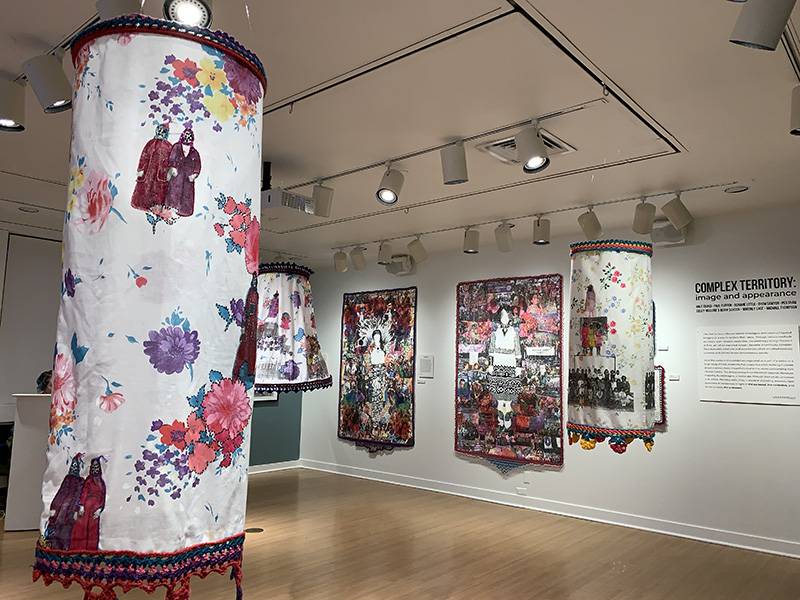My first experience of “Complex Territory” found me alone in the Girttz Gallery on a Tuesday afternoon. And although the room was utterly silent, I could almost hear a cacophony of voices rising the work of nine artists whose series projects comprise the exhibit. I could hear them talking to themselves as they fretted, pondered, considered, researched, and explored their unique obsessions in their unique styles. I could hear the intermittent times of silence as new information was processed and integrated. As I walked around the gallery, I began to hear the artists speaking to one another through their work. So much rich work in such close proximity is bound to park conversations.
And though the languages they speak, the particular visual vocabularies, represent a diversity of reference, influence, style, and method, there was, for me, a common thread, a singular note resonating throughout: the notion of home and it the role it plays in how we see and understand ourselves and the world.
As an artist my inspiration has arrived in this form. A theme approached from multiple angles, a series rooted in musical movements. I have taken these gifts and run with them. But it wasn’t until that Tuesday afternoon at the Giertz Gallery that I fully appreciated how and why this suits me so well, both as a creator and consumer of art. In a world of sound bites and Insta-images, quantity often comes at the loss of depth. And, in this writer’s view, depth is where the magic happens. But depth requires time, and time is sadly, a rare luxury. And this is what makes this exhibit that much more extraordinary and that much for important for you to see. I was reminded of another day spent at the Giertz Gallery listening to the wisdom of photograher Jason Reblando who advised young photographers and artists to cultivate curiosity, find a precise, yet rich subject matter and “go one inch wide and a mile deep.” It is good advice and I was glad to be reminded of it.

Image: Series of three framed ink drawings with framed typed narrative descriptions below. Paul Flippen’s series. Photo by Debra Domal
Each of the artists approaches the passage of time in a unique way. For Paul Flippen, it is the mapping of a man’s life; following his aging father from retirement to illness to death. As someone who traffics in both words and images, Flippen’s work resonated deeply with me. Each line drawing illustrated a key element from that stage, that specific point on the map. Directly below stood a typed bit of dialogue, a scene from the narrative evoked in such a way as to be highly specific yet universal. It took me right back to the stages of my own father’s illness and death and their residual emotions, many of which I’m still not fully able open myself to. Flippen’s work is not only a unique form of narrative expression, it is a brave example of working through the darkest places to find the deepest meaning and the most bittersweet beauty.

Image: Framed ink drawing of still pond with a framed, typed narrative description below it. “Stillness,” the last of Paul Flippen’s series. Photo by Debra Domal
Hale Ekini, whose work serves as the signature image for the exhibit, speaks across time and cultures. Using domestic materials (bedsheets, crocheted yarn) that honor her Turkish heritage as a canvas for images transfered from old family photos, she embeds a rainbow of cultural, gender, and religious symbols which serve to raise deeper questions about the construction of identity.

Image: Room shot of multicolored, patterned mix media collage. “Monument for Feisty Women of My Distant Land,” by Hale Ekinci, 2017, mixed media. Photo by Debra Domal

Image: Close-up detail of multicolored, patterned mix media collage. “Monument for Feisty Women of My Distant Land,” by Hale Ekinci, 2017, mixed media. Photo by Debra Domal.
My inner bookworm was thrilled to find Adrienne Liltle’s series “Mapping Mrs. Dalloway,” a series of digital photographs exploring both place and time in the Virigina Woolf classic. The last image of the flower shop brought me right back to the first lines of the book, and to the opening shots of yet another reimaging of the book, the film, based on Michael Cunningham’s homage to source book, “The Hours.” It is fascinating to see this dialogue reach across time and between genres, between photography and fiction, image and text, author and artist.

Image: Series of six framed black and white photographs by Adrienne Little from “Mapping Mrs. Dalloway,” showing a variety of street scenes. Photo by Debra Domal

Image: Famed black and white photograph by Adrienne Little from “Mapping Mrs. Dalloway,” showing a flower stall. Photo by Debra Domal
In the spirit of this exhibition, I leave you here with my first in a series of observations from the exhibit. My thoughts on the work of Whitney Sage and Peg Shaw will follow in a later piece that will run after their respective artist talks which I urge you to attend. Make time for this exhibit. Make time to consider after you have left. And perhaps, make time for you yourself to consider your own complex territory.
Complex Territory
Giertz Gallery at Parkland College
2400 W Bradley Avenue, Champaign
February 10th through March 24th
Whitney Sage artist talk: March 2rd, 3 p.m. Lecture Hall C118
Peg Shaw artist talk: March 3rd, 10:30 a.m., Lecture Hall C118
Get gallery hours here








